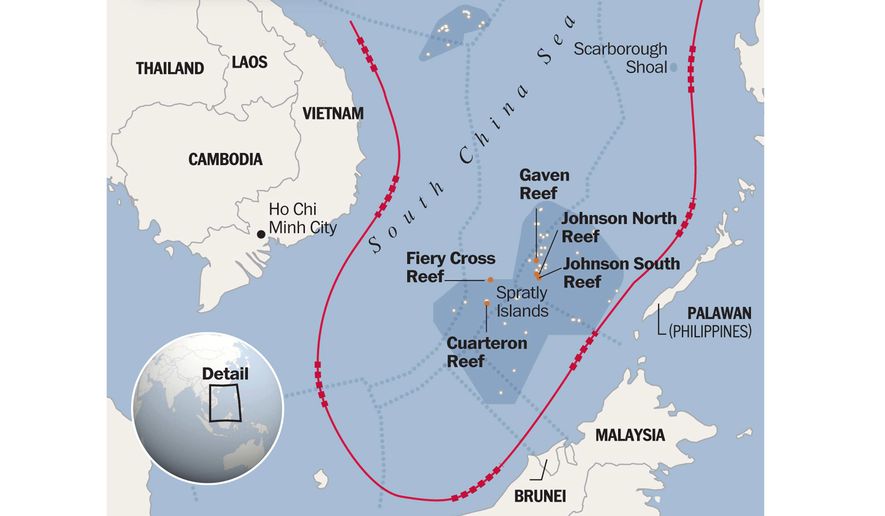OPINION:
China intends to ignore the Obama administration’s demand that it halt its military base-building in the South China Sea. It is time for Washington to face a new reality: Either it leads the way to a new “armed peace” in this region, or China will soon commence a war for domination.
First, it is important to understand why China will continue to ignore Washington, as it has rebuffed nearly 20 years of regional diplomacy seeking to avoid conflict over this crucial maritime region, now used annually by 40 percent of the world’s merchant ships.
Simply put, for China’s Communist Party leadership, control of the South China Sea is essential to protect Hainan Island as a base from which it intends to project global military and space power, and which it views as essential to ensuring the survival of its political dictatorship.
Already, Hainan Island has become a base for projecting nuclear power from China’s growing fleet of nuclear-powered and nuclear-armed ballistic missile submarines. In the late 1990s, China started building a new underground base there to protect these submarines. Hainan will also host one or two aircraft carrier and large amphibious assault ship groups. These can be used to protect the submarines and to project Chinese military influence to the Middle East and beyond.
From 2016, a new space launch center on Hainan for Chinese heavy space-launch vehicles will support China’s military ambitions in low earth orbit and on the moon. Most of these launches will be vulnerable as they pass over the South China Sea, so China’s People’s Liberation Army (PLA) is militarizing this region to better impose eventual control.
Perhaps as early as next year, China could start basing up to 30 combat aircraft and a squadron of combat ships at its new base at Fiery Cross Reef. Similarly sized PLA forces could follow on new bases being built on Subi Reef and Mischief Reef — a mere 134 nautical miles from the Philippines but 800 nautical miles from mainland China and the vital commercial sea lanes of the Palawan Trench.
There should be no doubt that China will impose military control when it is able and unchallenged. China used deadly force to take the Paracel Islands away from South Vietnam in 1974, and in 1988 massacred Vietnamese troops on reefs in the Spratly Island group. Beijing exploited an ebb in U.S.-Philippines relations to capture Mischief Reef in 1995 and then forced Filipino ships off Scarborough Shoal in 2013.
Since late 2013, China has deployed hundreds of civilian transports to build its islands, and with additional PLA support, this force could be used to assault islands occupied by the Philippines, Taiwan and Vietnam.
China’s quest for dominance, however, can be turned into a major strategic blunder, but only if Washington corrects the mistake of successive administrations of undervaluing security in the South China Sea as a matter of American interest. It is central to U.S. naval (and air) operations to maintain unimpeded access and freedom of navigation in clearly recognized international waters and air space. For 30 years, U.S. officials have refused to come to terms with China’s ambitions, in part because of China’s “low intensity” strategy.
It is not yet too late for Washington to neutralize China’s ambitions in the South China Sea and severely crimp its global ambitions.
The plan is simple: work with the Philippines to build new island bases astride the Palawan Trench and then deploy and transfer the means to destroy China’s new islands bases should it use them. As a first line of defense, Manila and Washington could build three new island bases armored with missiles close to Palawan, the Visayas and Luzon.
Washington should then quickly deploy and transfer to the Philippines multiple squadrons of multi-role fighter aircraft. A new lend-lease protocol should be instituted to facilitate such a transfer. But more essential would be the rapid development and deployment of a longer-range version of the Lockheed-Martin short-range ballistic missile equipped with deep penetrating and fuel-air-explosive warheads. About 300 of these could immediately destroy China’s new island bases if it uses force from them.
In response, China should be expected to threaten nuclear conflict. This is why President Obama should reverse his ill-advised 2010 decision to destroy the last secure U.S. tactical nuclear cruise missile, and rapidly deploy a replacement. Existing missiles should be immediately be restored in our submarine force. It would be a credible deterrent to both China and to North Korea as well.
Only when its regional and global military ambitions can be thwarted by this level of force will Beijing be deterred from imposing military dominance and return to non-military solutions, of which there are plenty. The latest peace plan was offered on May 25, when Taiwan’s President Ma Ying Jeou suggested shelving respective territorial claims in favor of mutual economic development.
China has proven that it regards war as a means to obtain its goals in the South China Sea. Only when it concludes that it cannot win such a war will Beijing then consider the alternatives. For Washington, the states of Southeast Asia, Japan and Taiwan, creating conditions for an “armed peace” offers the best alternative to war.
• James A. Lyons, a U.S. Navy retired admiral, was commander-in-chief of the U.S. Pacific Fleet and senior U.S. military representative to the United Nations. Richard Fisher is a senior fellow with the International Assessment and Strategy Center.




Please read our comment policy before commenting.